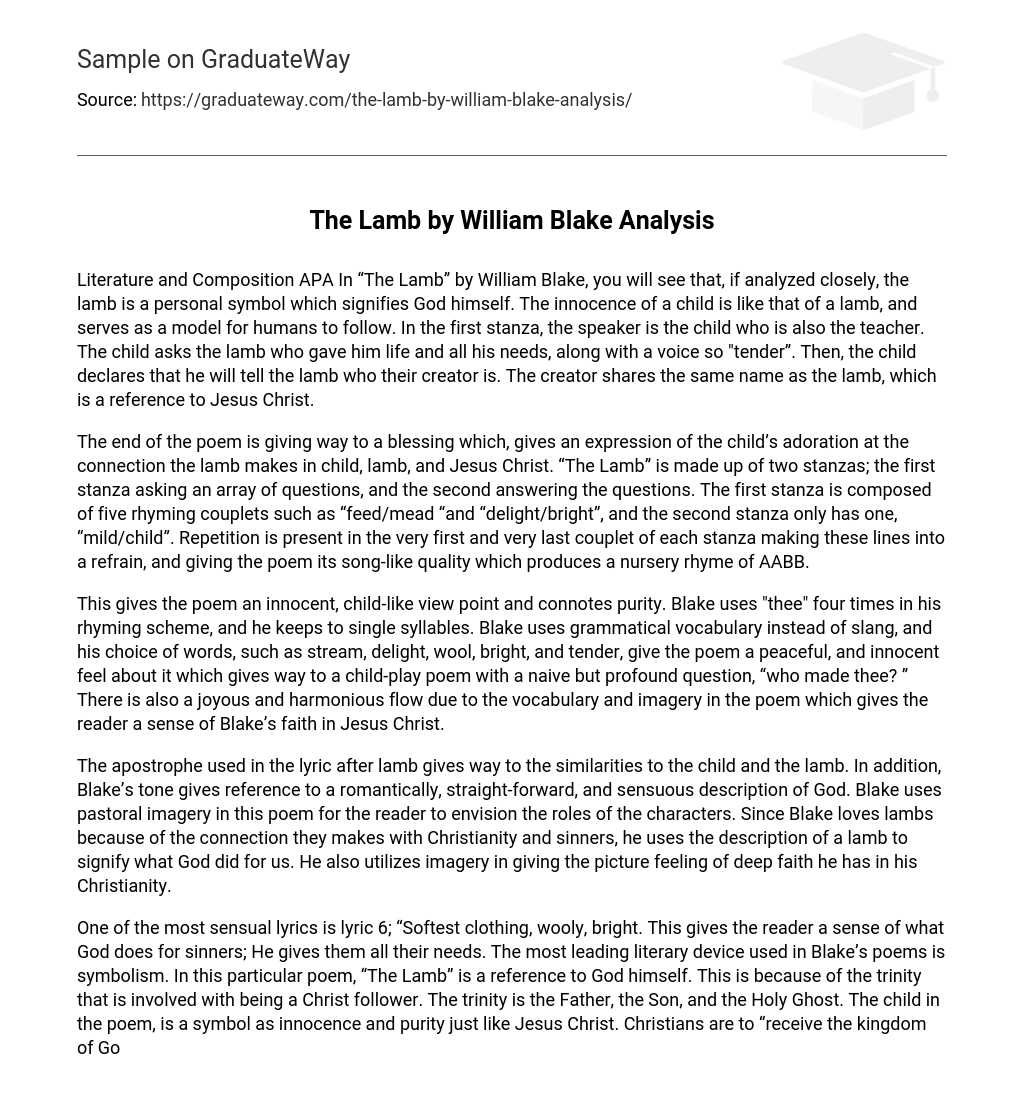Literature and Composition APA In “The Lamb” by William Blake, you will see that, if analyzed closely, the lamb is a personal symbol which signifies God himself. The innocence of a child is like that of a lamb, and serves as a model for humans to follow. In the first stanza, the speaker is the child who is also the teacher. The child asks the lamb who gave him life and all his needs, along with a voice so “tender”. Then, the child declares that he will tell the lamb who their creator is. The creator shares the same name as the lamb, which is a reference to Jesus Christ.
The end of the poem is giving way to a blessing which, gives an expression of the child’s adoration at the connection the lamb makes in child, lamb, and Jesus Christ. “The Lamb” is made up of two stanzas; the first stanza asking an array of questions, and the second answering the questions. The first stanza is composed of five rhyming couplets such as “feed/mead “and “delight/bright”, and the second stanza only has one, “mild/child”. Repetition is present in the very first and very last couplet of each stanza making these lines into a refrain, and giving the poem its song-like quality which produces a nursery rhyme of AABB.
This gives the poem an innocent, child-like view point and connotes purity. Blake uses “thee” four times in his rhyming scheme, and he keeps to single syllables. Blake uses grammatical vocabulary instead of slang, and his choice of words, such as stream, delight, wool, bright, and tender, give the poem a peaceful, and innocent feel about it which gives way to a child-play poem with a naive but profound question, “who made thee? ” There is also a joyous and harmonious flow due to the vocabulary and imagery in the poem which gives the reader a sense of Blake’s faith in Jesus Christ.
The apostrophe used in the lyric after lamb gives way to the similarities to the child and the lamb. In addition, Blake’s tone gives reference to a romantically, straight-forward, and sensuous description of God. Blake uses pastoral imagery in this poem for the reader to envision the roles of the characters. Since Blake loves lambs because of the connection they makes with Christianity and sinners, he uses the description of a lamb to signify what God did for us. He also utilizes imagery in giving the picture feeling of deep faith he has in his Christianity.
One of the most sensual lyrics is lyric 6; “Softest clothing, wooly, bright. This gives the reader a sense of what God does for sinners; He gives them all their needs. The most leading literary device used in Blake’s poems is symbolism. In this particular poem, “The Lamb” is a reference to God himself. This is because of the trinity that is involved with being a Christ follower. The trinity is the Father, the Son, and the Holy Ghost. The child in the poem, is a symbol as innocence and purity just like Jesus Christ. Christians are to “receive the kingdom of God like a child” (Luke 18:17, ESV).
This means that we are to have child-like faith, and trust in God, just like children do in their parents. In the second stanza, the child tells the lamb who created him. In lyrics 13 and 14, he says “He is called by thy name/For he calls himself a Lamb. In Christianity, this is Jesus Christ, the son of God. In explaining the trinity earlier, this is another reference to God. Lyrics 15 and 16 say “He is meek, and he is mild/He became a little child. Jesus Christ was sent down to bare people’s sin. This could only happen if a child was born of purity (from a virgin).
In the Gospel’s, it accounts for the virgin birth and a “man” who led a sinless life. Jesus was meek and mild because he was of love. The lamb is another reference to the Gospel’s. John 3:16 (ESV) simply states “For God so loved the world, that he gave his only Son, that whoever believes in him should not perish but have eternal life. Jesus Christ was the lamb sacrificed on the cross for people to gain righteousness. It’s called the Great Exchange, and people are now able to communicate with their Father because of this. This is why people should follow Jesus as their prime example.
In another poem by Blake called “The Tyger”, he contrasts his earlier question of “who made thee”, to “Did he who made the Lamb make thee? ” In this poem, Blake talks about the beauty of innocence and the horror of sin. The Tyger is God’s creation in the world…people. In the beginning, the Tyger asks “What immortal hand or eye/Could frame thy fearful symmetry? This is in contrast with “The Lamb” since God’s creation is now being questioned. Lines 5-8 clearly show Blake’s questioning of the creator. Throughout the poem Blake asks questions to his Maker such as what God could create the ferocity and strength of his heart?
The sea of flames in the tyger’s eyes? The vehemence of his brain? And on the same note, did that same God make the Lamb; referencing Jesus. The Lamb is a wonderful put together lyrical poem where Jesus, as always, takes the lead. From the use of imagery and symbolism, to its flow of words and feel of happy innocence an individual will know off hand who and what this poem is about. The knowledge and truth Blake imprinted in his lyrics is undeniable and left for topologists and Christians to ponder the wonders of Gods graceful love.





